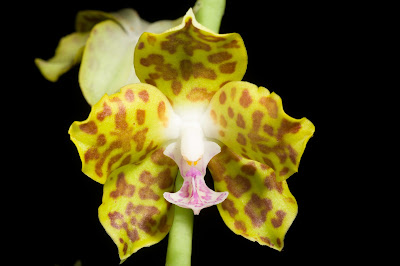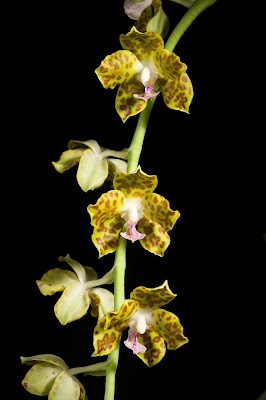Phalaenopsis hygrochila - The Moist Lip Phalaenopsis is found growing in evergreen and semi-deciduous forests on limestone cliffs...
Phalaenopsis hygrochila also called as The Moist Lip Phalaenopsis, Hygrochilus parishii, Phalaenopsis marriottiana var. parishii, Phalaenopsis tigrina, Stauropsis parishii, Vanda parishii, Vandopsis parishii, is a species of the genus Phalaenopsis. This species was described by Julian Mark Hugh Shaw in 2015.
IDENTIFY PHALAENOPSIS HYGROCHILA - THE MOIST LIP PHALAENOPSIS
Phalaenopsis hygrochila is native to Assam, China South-Central, East
Himalaya, Laos, Myanmar, Thailand, Vietnam. It is found growing in evergreen
and semi-deciduous forests on limestone cliffs or in primary montane forests
at elevations of 100 to 1500 meters above sea level.
It is a large sized, hot to cool growing, epiphytic orchid with sturdy, 20 to 40 cm, more or less flattened stem. The leaves are 3 to 5 (but much more numerous in culture - more than 20), elliptic-oblong, unequally, obtusely bilobed or deeply emarginate apically, to 25 cm long by 2.5 to 7.5 cm wide.
The Moist Lip Phalaenopsis blooms in the late winter and spring from the axillary, 45 cm long, 5 to several flowered inflorescence that is longer than the leaves, with ovate-elliptic, acute or subacute, cucullate bracts. The flowers are fragrant, waxy, long lasting, up to 6 cm in diameter; petals and sepals are pale greenish yellow with more or less dotted with brown or brown-red, with a whitish or white base; column white; labellum slightly purplish purple, paler towards the margins.
PHALAENOPSIS HYGROCHILA - THE MOIST LIP PHALAENOPSIS CARE AND CULTURE
Cultural information should only be used as a guide, and should be to be adapted to suit you. Your physical location; where you grow your plants, how much time you have to devote to their care, and many other factors, will need to be taken into account. Only then can you decide on the cultural methods that best suit you and your plants.
Light:
Phalaenopsis hygrochila The Moist Lip Phalaenopsis needs the light level of 27000 - 43000 lux during the early growth, this may require 50% shading especially in summer months. Regular growth light level should be at 43000 - 54000 lux (30% shading during summer). In cool areas or in winter months, full sun is tolerated.
Temperature:
The Moist Lip Phalaenopsis needs the daytime temperature of 28-30 ° C, and 21 ° C at night, with a daily difference of 7-8 ° C in summer. In winter the average temperature is 28-29 ° C, but the nights are cooler, 19-21 ° C, which increases the daily difference to 10-11 ° C. A temperature of 19°C is particularly necessary in the event that the induction of buds needs to be enhanced in conditions of inadequate light or high daytime temperatures.
The consequently temperatures lower than 15°C and 32°C and above should be avoided. The plant tend to stop growing and therefore it is necessary to take steps to reduce the temperature by improving ventilation or misting the floor etc. Continued periods of exposure to the temperature below 10 ° C or a rapid drop in temperature can cause chilling injury which ultimately results yellow sunken spots on the leaves. Further, cooler temperature (below recommendation) slows down growth and cause bud falling before blooming.
Humidity:
Phalaenopsis hygrochila needs the humidity levels of 50 - 80%. At sufficient humidity, plants grow lushly and leave looks healthy. Insufficient humidity cause stunting of plant, accelerate premature falling of buds, dehydrated and shriveled leaves, papery texture of flower edges. You can use a shallow tray of pebbles filled with water to increase humidity around your plants. Be sure the pot does not sit in water as this will rot the roots. Misting can also help in increasing humidity for limited period, but it causes leaf spot diseases if there is not good air circulation.
Good air circulation is essential for good plant growth, supplying oxygen and carbon dioxide and promoting the quick drying off of leaves thus preventing fungal, bacterial and red spider problems. The air surrounding the plant must be moist. Bad ventilation causes poor growth and immature buds to yellow and drop off. Ceiling and oscillating fans are effective for providing gentle air flow in hobby greenhouse or indoor growing area. Both can cover large areas with a constantly changing air flow pattern without excessive drying the plants.
Substrate, growing media and repotting:
The Moist Lip Phalaenopsis are usually grown in plastic or clay pot with a mixture of 12-16 mm of bark as substrate. Small pieces of limestone can be added to the substrate. 25-30% of the media should be charcoal or tile pieces to ensure adequate drainage. You can use the growing media consist of 4 part coconut husk, 1 part medium charcoal, 1 part medium size perlite and 1 part medium sphagnum moss.
The plant should be repotted about every two years or when the potting medium is decomposed. If brown particles from breakdown of bark drain from the pot during watering, the bark is no longer satisfactory. If you insert your finger into the bottom hole in the pot and the bark is no longer firm, it is time to repot. It is best to repot in spring or summer, and just after the plant has completed its bloom cycle. Remove the plant from the pot, wash the roots, and remove any dead roots. Live roots will be whitish, firm, and plump; dead roots will be brown, wiry, and dry. Use a sterile razor blade or sterile pruner to remove them. Always sterilize your tools between plants so as not to spread disease. Use a suitable disinfectant such as bleach.
Watering:
Phalaenopsis hygrochila should be kept very moist all year round, but there should be excellent drainage and the substrate around the roots should never be soggy or stale. It is suggested to water with warm water at a temperature of about 21 ° C. Watering is needed twice per day during very hot and dry months, and only 2-3 times per week during wet months or none at all for matured plants.
It is best to water in the morning. Place the plant in the sink and use tepid water. Do not use salt-softened or distilled water. Let the water run through the plant for a minute or so. Be sure to let the plant drain completely. If any water remains in the crown (where the leaves join in the center) use a paper towel to blot the water to avoid crown rot.
Fertilizer:
Fertilize your plant once each week after watering, or three weeks out of four. Use a balanced orchid fertilizer such as 20-20-20 at half strength the recommended concentration on the label. It is important to always give the plants a good watering before fertilizing, otherwise the roots will burn.
Weak fertilizer applied frequently is better than strong application. Reduction of fertilizers is suggested once flower spikes and during low light conditions. It is important to note that feeding depends upon some other environmental factors, the higher the light the more food is required; the more food is available at the roots the more of water is necessary to prevent salt damage to the roots. Plants grown under lower light and temperature, less water and feed is required.
To avoid mineral deposits building up during periods of heavy fertilization, it is advisable to rinse the containers approximately every month. Rinsing is especially important where the water is highly mineralized. First, water the plant normally to dissolve the accumulated salts, and after about an hour, rinse the substrate with water equal to twice the volume of the container.
Rest period:
The Moist Lip Phalaenopsis should be limited in the amount of water during 2-3 winter months. They should dry up a bit between waterings, but they must not be left without water for too long. Fertilization should be reduced or eliminated until new growths appear in spring, at which point regular watering resumes.
BUY PHALAENOPSIS HYGROCHILA - THE MOIST LIP PHALAENOPSIS AND RELATED PRODUCTS
BUY ANOTHERS SPECIES AND VARIETIES OF PHALAENOPSIS ORCHID GENUS HERE!















COMMENTS